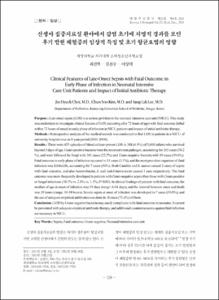신생아 집중치료실 환아에서 감염 초기에 치명적 경과를 보인 후기 발현 패혈증의 임상적 특징 및 초기 항균요법의 영향
- Alternative Author(s)
- Choi, Jin Hyeok; Kim, Chun Soo; Lee, Sang Lak
- Journal Title
- 대한주산의학회잡지
- ISSN
- 1229-2605
- Issued Date
- 2011
- Keyword
- Sepsis; Fatal outcome; Gram-negative; Neonatal intensive care unit; 패혈증; 치명적 경과; 그람 음성; 신생아 집중치료실
- Abstract
- Purpose : Late-onset sepsis (LOS) is a serious problem in the neonatal intensive care unit (NICU). This study
was undertaken to investigate clinical features of LOS (occurring after 72 hours of age) with fatal outcome (lethal
within 72 hours of onset) in early phase of infection in NICU patients and impact of initial antibiotic therapy.
Methods : Retrospective analysis of the medical records was conducted to find LOS in patients in a NICU of
university hospital over an 8-year period (2001-2008).
Results : There were 455 episodes of blood culture-proven LOS in 388 (6.9%) of 5,608 infants who survived
beyond 3 days of age. Gram-positive bacteria were the most common pathogen, accounting for 265 cases (58.2
%), and were followed by fungi with 101 cases (22.2%) and Gram-negative bacteria with 89 cases (19.6%).
Fatal outcome in early phase of infection occurred in 14 cases (3.1%), and the most prevalent organism of fatal
infection was Klebsiella , accounting for 7 cases (50%). Both Candida and S. aureus caused 2 cases of sepsis
with fatal outcome, and also Acinetobacter, E. coli and Enterococcus caused 1 case respectively. The fatal
outcome was more frequently developed in patients with Gram-negative sepsis than those with Gram-positive
or fungal infections (10.1% vs. 2.0% vs. 1.1%; P <0.05). In clinical findings of patients with fatal outcome, the
median of age at onset of infection was 19 days (range: 6-94 days), and the interval between onset and death
was 29 hours (range: 10-58 hours). Severe sepsis at onset of infection was developed in 7 cases (50.0%), and
the use of adequate empirical antibiotics was done in 10 cases (71.4%) of them.
Conclusion : LOS by Gram-negative bacteria may easily complicate with fatal outcome in neonates. It cannot
be prevented with adequate empirical antibiotic therapy, and additional countermeasures against fatal infection
are necessary in NICU.
목적 : 후기 발현 패혈증은 신생아 집중치료실에서 직면하는 심각한 문제 중의 하나이다. 이 연구는 신생아 집중치료실
환아에서 감염 초기에 치명적 경과(발생 후 72시간 내 사망한 경우로 정함)를 보인 후기 발현 패혈증(생후 72시간 후에
발생한 경우로 정함)의 임상적 특징과 초기 항균요법의 영향을 알아보고자 시행하였다.
방법 : 2001년부터 2008년까지 8년간 일개 대학병원 신생아 집중치료실에 입원한 환아 중 후기 발현 패혈증을 가진 경
우를 대상으로 의무기록을 후향적으로 조사하였다.
결과 : 생후 3일 이후 생존한 5,608명의 환아 중 388명(6.9%)에서 총 455례의 후기 발현 패혈증이 발생하였다. 원인균
의 분포는 그람 양성균이 265례(58.2%)로 가장 많았고, 진균101례(22.2%), 그람 음성균 89례(19.6%)였다. 치명적 경과
는 모두 14례(3.1%)에서 동반되었는데 Klebsiella가 7례(50.0%)로 가장 많았고, 그 외에 Candida와 S. aureus가 각 2례,
Acinetobacter 및 E. coli, Enterococcus가 각각 1례였다. 그람 음성균 패혈증은 진균이나 그람 양성균에 의한 감염에
비해 치명적 경과의 동반율이 높았다(10.1% 대 2.0% 대 1.1%; P<0.05). 치명적 감염의 발생 시기는 중앙값 생후 19일(6-94
일)이었고, 사망은 감염 후 29시간(10-58시간) 경이었다. 임상소견 중 감염의 발현 당시 중증 패혈증을 보인 환아는 7례
(50.0%)였고, 초기 경험적 항균요법은 10례(71.4%)에서 적합하였다.
결론 : 신생아 집중치료실 환아에서 그람 음성균에 의한 후기 발현 패혈증은 감염 초기에 치명적 경과를 동반하기 쉽다.
이는 적합한 경험적 항균요법으로 막기 어려우며, 치명적 감염을 예방하기 위한 추가적인 대책이 필요하다.
- Alternative Title
- Clinical Features of Late-Onset Sepsis with Fatal Outcome in
Early Phase of Infection in Neonatal Intensive
Care Unit Patients and Impact of Initial Antibiotic Therapy
- Department
- Dept. of Pediatrics (소아청소년학)
- Publisher
- School of Medicine
- Citation
- 최진혁 et al. (2011). 신생아 집중치료실 환아에서 감염 초기에 치명적 경과를 보인
후기 발현 패혈증의 임상적 특징 및 초기 항균요법의 영향. 대한주산의학회잡지, 22(4), 329–336.
- Type
- Article
- ISSN
- 1229-2605
- Appears in Collections:
- 1. School of Medicine (의과대학) > Dept. of Pediatrics (소아청소년학)
- 파일 목록
-
-
Download
 oak-bbb-3633.pdf
기타 데이터 / 705.3 kB / Adobe PDF
oak-bbb-3633.pdf
기타 데이터 / 705.3 kB / Adobe PDF
-
Items in Repository are protected by copyright, with all rights reserved, unless otherwise indicated.